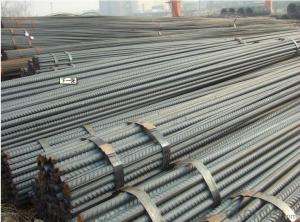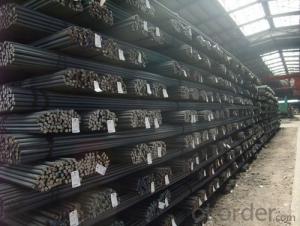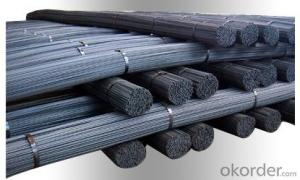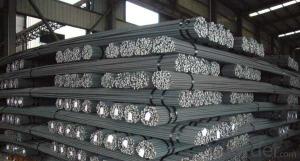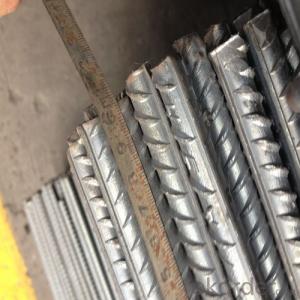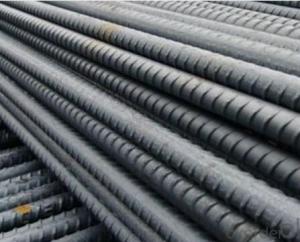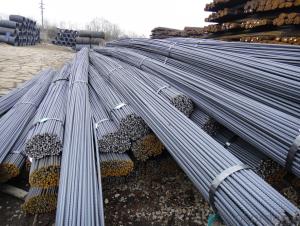ASTM A615 GR40 DEFORMED STEEL BAR
- Loading Port:
- China Main Port
- Payment Terms:
- TT OR LC
- Min Order Qty:
- -
- Supply Capability:
- -
OKorder Service Pledge
OKorder Financial Service
You Might Also Like
Product Description:
Specifications of Deformed Steel Bar:
Standard | GB | HRB335, HRB400, HRB500 | |
UK | G460B, B500A, B500B,B500C | | |
USA | GR40, GR60 | | |
Diameter | 6mm,8mm,10mm,12mm,14mm,16mm,18mm,20mm, 22mm,25mm,28mm,32mm,36mm,40mm,50mm | | |
| | |||
Length | 6M, 9M,12M or as required | | |
Place of origin | Hebei, China mainland | | |
Application | building,construction,road,bridge etc | | |
Brand name | DRAGON | | |
Theoretical weight and section area of each diameter as below for your information:
Diameter(mm) | Section area (mm²) | Mass(kg/m) |
6 | 28.27 | 0.222 |
8 | 50.27 | 0.395 |
10 | 78.54 | 0.617 |
12 | 113.1 | 0.888 |
14 | 153.9 | 1.21 |
16 | 201.1 | 1.58 |
18 | 254.5 | 2.00 |
20 | 314.2 | 2.47 |
22 | 380.1 | 2.98 |
25 | 490.9 | 3.85 |
28 | 615.8 | 4.83 |
32 | 804.2 | 6.31 |
36 | 1018 | 7.99 |
40 | 1257 | 9.87 |
50 | 1964 | 15.42 |
Usage and Applications of Deformed Steel Bar:
Deformed bar is widely used in buildings, bridges, roads and other engineering construction. Big to highways, railways, bridges, culverts, tunnels, public facilities such as flood control, dam, small to housing construction, beam, column, wall and the foundation of the plate, deformed bar is an integral structure material. With the development of world economy and the vigorous development of infrastructure construction, real estate, the demand for deformed bar will be larger and larger..
Packaging & Delivery of Deformed Steel Bar:
Packaging Detail: products are packed in bundle and then shipped by container or bulk vessel, deformed bar is usually naked strapping delivery, when storing, please pay attention to moisture proof. The performance of rust will produce adverse effect.
Each bundle weight: 2-3MT, or as required
Payment term: TT or L/C
Delivery Detail: within 45 days after received advanced payment or LC.
Label: to be specified by customer, generally, each bundle has 1-2 labels
Trade terms: FOB, CFR, CIF
Deformed Steel Bar in Coil

Produce Line of Deformed Steel Bar
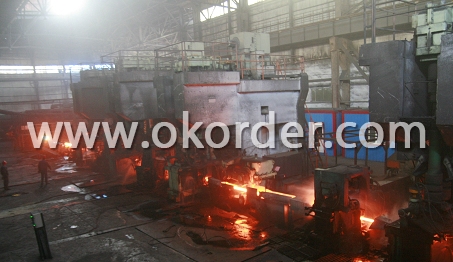
Note:
1. Our products are produced according to national standard (GB), if not, supply according to national standards (GB) or agreement as customer required.
2. Other Grade and Standard Deformed Steel Bar we can supply:
Grade: GR40/GR60, G460B/B500A/B500B/B500C,BST500S
Standard: ASTM, BS, DIN
The Minimum Order Quantity of these products is high, and need to be confirmed.
3. We can not only supply Deformed Steel Bar; if you need anything about building materials, please contact us for further information.
4. Please send us your detail specifications when inquire. We will reply to you as soon as possible. We sincerely hope we can establish a long stable business relationship.
- Q: Can steel rebars be used in offshore oil and gas platforms?
- Yes, steel rebars can be used in offshore oil and gas platforms. They are commonly employed as reinforcement in concrete structures to enhance their strength and durability. Rebars provide structural support and help withstand the harsh environmental conditions and heavy loads experienced in offshore operations.
- Q: What are the guidelines for spacing and positioning steel rebars in concrete structures?
- The guidelines for spacing and positioning steel rebars in concrete structures vary depending on factors such as the type of structure, its design requirements, and the specific project specifications. However, some general guidelines include maintaining proper cover (distance between the rebar and the concrete surface), ensuring adequate spacing between rebars to allow for proper concrete flow and consolidation, and properly securing the rebars in place to prevent movement during concrete pouring and curing. Additionally, the positioning and arrangement of rebars should follow the structural engineer's design and reinforcement drawings to ensure the desired strength and structural integrity of the concrete structure. It is crucial to consult and adhere to local building codes and regulations as they may provide specific requirements for rebar spacing and positioning in different applications.
- Q: How can the quality of steel rebars be tested?
- The quality of steel rebars can be tested through various methods to ensure their strength and reliability. Some common techniques include: 1. Visual Inspection: This involves examining the rebars for any visible defects such as surface cracks, unevenness, or corrosion that could affect their performance. 2. Chemical Composition Analysis: The composition of the steel rebars can be determined through spectroscopy or other similar methods to ensure they meet the required standards. This analysis verifies the presence and percentage of various elements such as carbon, manganese, and silicon. 3. Tensile Strength Testing: A sample of the steel rebar is subjected to tension until it fractures. The maximum force applied to the bar before breaking determines its tensile strength. This test helps identify any weak spots or inconsistencies within the rebar. 4. Bend Test: This test evaluates the ductility of the rebars by bending them to a specific angle without any signs of cracking or fracture. It ensures the rebar can withstand bending and shaping during construction without compromising its structural integrity. 5. Ultrasonic Testing: Ultrasonic waves are used to detect internal flaws or defects within the rebars. This non-destructive testing method helps identify any hidden cracks, voids, or inclusions that may weaken the rebar. 6. Hardness Test: The hardness of the steel rebars can be determined using the Rockwell or Brinell hardness test. This test measures the resistance of the rebar's surface to indentation, providing an indication of its strength. 7. Corrosion Resistance Test: The rebars can undergo corrosion testing, such as salt spray testing or electrochemical methods, to assess their resistance against rust and other forms of corrosion. By utilizing a combination of these testing methods, manufacturers, construction companies, and engineers can ensure that steel rebars meet the required quality standards and can withstand the intended load and environmental conditions.
- Q: What are the factors that affect the durability of steel rebars in concrete?
- There are several factors that can affect the durability of steel rebars in concrete. These include the quality of the steel used, the level of corrosion protection provided, the design and construction practices, the exposure conditions (such as moisture and temperature), and the presence of aggressive chemicals in the surrounding environment.
- Q: Can steel rebars be used in structures with high resistance to abrasion?
- Structures that require high resistance to abrasion can benefit from the use of steel rebars. Reinforced concrete structures often incorporate steel rebars to enhance their strength and durability. The specific steel chosen for rebars is known for its exceptional tensile strength and ability to withstand various environmental conditions. While the rebars themselves may not possess inherent resistance to abrasion, the concrete surrounding them offers protection against this. When properly designed and constructed, reinforced concrete structures with steel rebars can endure significant levels of abrasion without compromising their structural integrity. For areas with particularly harsh abrasion or corrosive environments, epoxy-coated rebars can be employed to provide an additional layer of protection against both abrasion and corrosion.
- Q: What are the common mistakes to avoid while using steel rebars?
- Some common mistakes to avoid while using steel rebars include improper placement and spacing, insufficient concrete cover, using rusty or damaged rebars, improper anchoring or tying, and neglecting to clean and prepare the rebars before installation.
- Q: How long do steel rebars typically last?
- Steel rebars typically have a long lifespan and can last for several decades. The exact duration of their lifespan depends on various factors, such as the quality of the rebar, the environmental conditions it is exposed to, and the maintenance practices implemented. Generally, steel rebars are designed to be resistant to corrosion, which is one of the main factors that can affect their longevity. However, over time, rebars may experience some corrosion due to exposure to moisture, chemicals, or other corrosive agents. This can potentially reduce their lifespan. Regular inspections, maintenance, and the application of protective coatings can help extend the lifespan of steel rebars. With proper care, steel rebars can typically last 30 to 50 years or even longer.
- Q: Can steel rebars be used in structures with high resistance to fire?
- Yes, steel rebars can be used in structures with high resistance to fire. Steel has a high melting point and excellent fire resistance properties, making it a suitable choice for reinforcing structures that need to withstand high temperatures and fire hazards.
- Q: What are the safety precautions when handling steel rebars?
- When handling steel rebars, it is important to follow several safety precautions. Firstly, always wear appropriate personal protective equipment (PPE) such as gloves, goggles, and steel-toed boots to protect yourself from potential injuries. Secondly, ensure that the work area is clear of any debris or obstacles that may cause trips or falls. Additionally, use proper lifting techniques and team lifting when necessary to avoid strain or back injuries. It is crucial to be aware of the weight and length of the rebars being handled to prevent them from falling or causing accidents. Lastly, remember to store and stack the rebars securely to prevent them from toppling over and causing injuries.
- Q: How are steel rebars transported to the construction site?
- Steel rebars, also known as reinforcing bars, are typically transported to construction sites using various methods. One common method is by truck transportation. The rebars are loaded onto flatbed trucks or trailers and secured using straps or chains to prevent any movement during transit. These trucks are specifically designed with sturdy frames and loading mechanisms to handle the weight and length of the rebars. Another method is by rail transportation. Steel rebars can be loaded onto rail cars, either on flatcars or in specialized containers, and transported to the construction site. This method is often used for long-distance transportation, as it is more cost-effective and efficient for large quantities of rebars. In some cases, rebars can also be transported by sea or barge for construction projects located near waterways. They are loaded onto ships or barges and secured to prevent any damage or movement during transit. This method is commonly used for projects that require large quantities of rebars or for construction sites located on islands or in coastal areas. Once the steel rebars arrive at the construction site, they are typically unloaded using cranes or forklifts. The rebars are then stored in designated areas or directly used for reinforcement in the construction process. It is essential to handle the transportation of rebars with care to ensure their structural integrity and prevent any potential accidents or damage during transit.
Send your message to us
ASTM A615 GR40 DEFORMED STEEL BAR
- Loading Port:
- China Main Port
- Payment Terms:
- TT OR LC
- Min Order Qty:
- -
- Supply Capability:
- -
OKorder Service Pledge
OKorder Financial Service
Similar products
Hot products
Hot Searches
Related keywords
